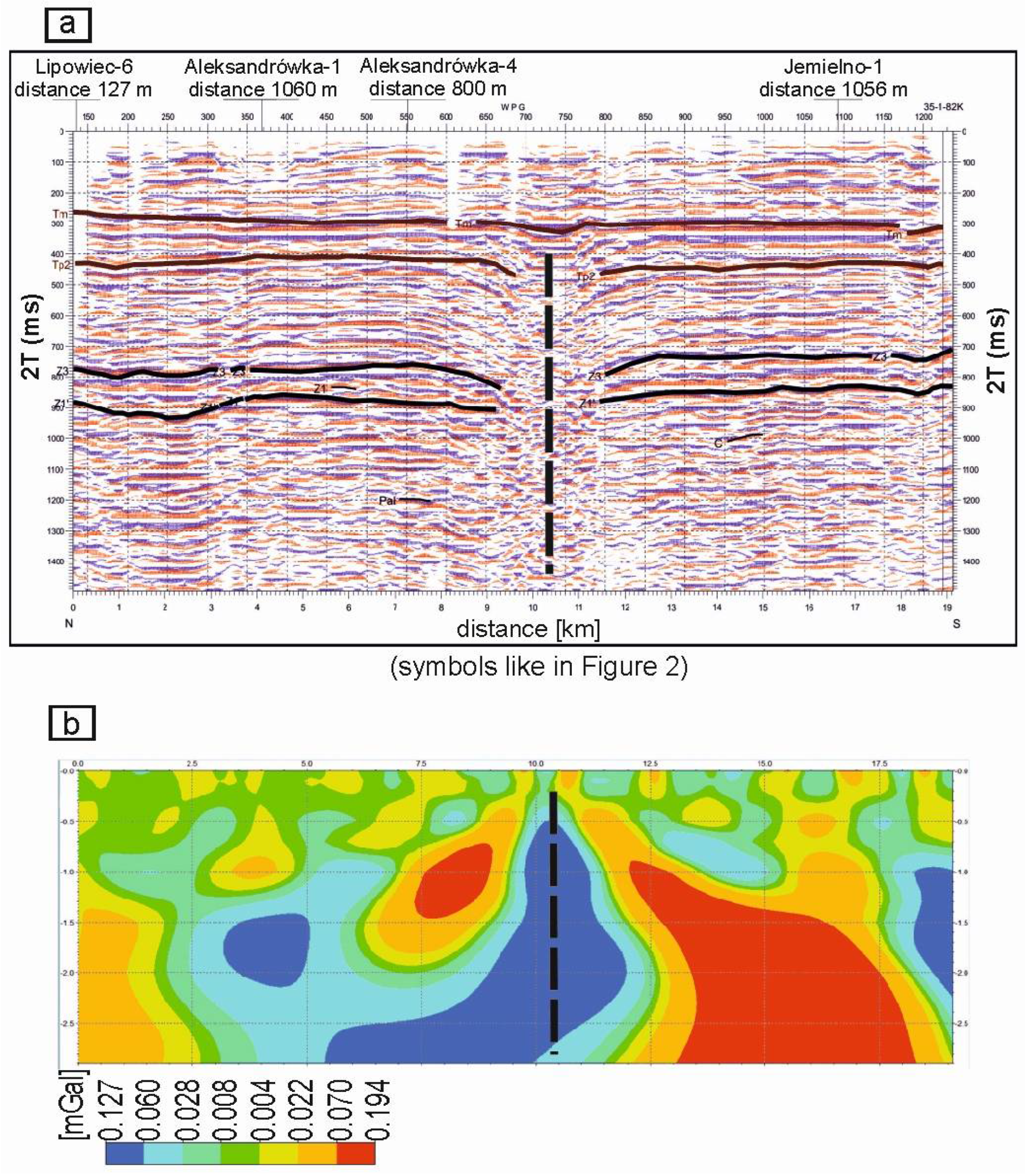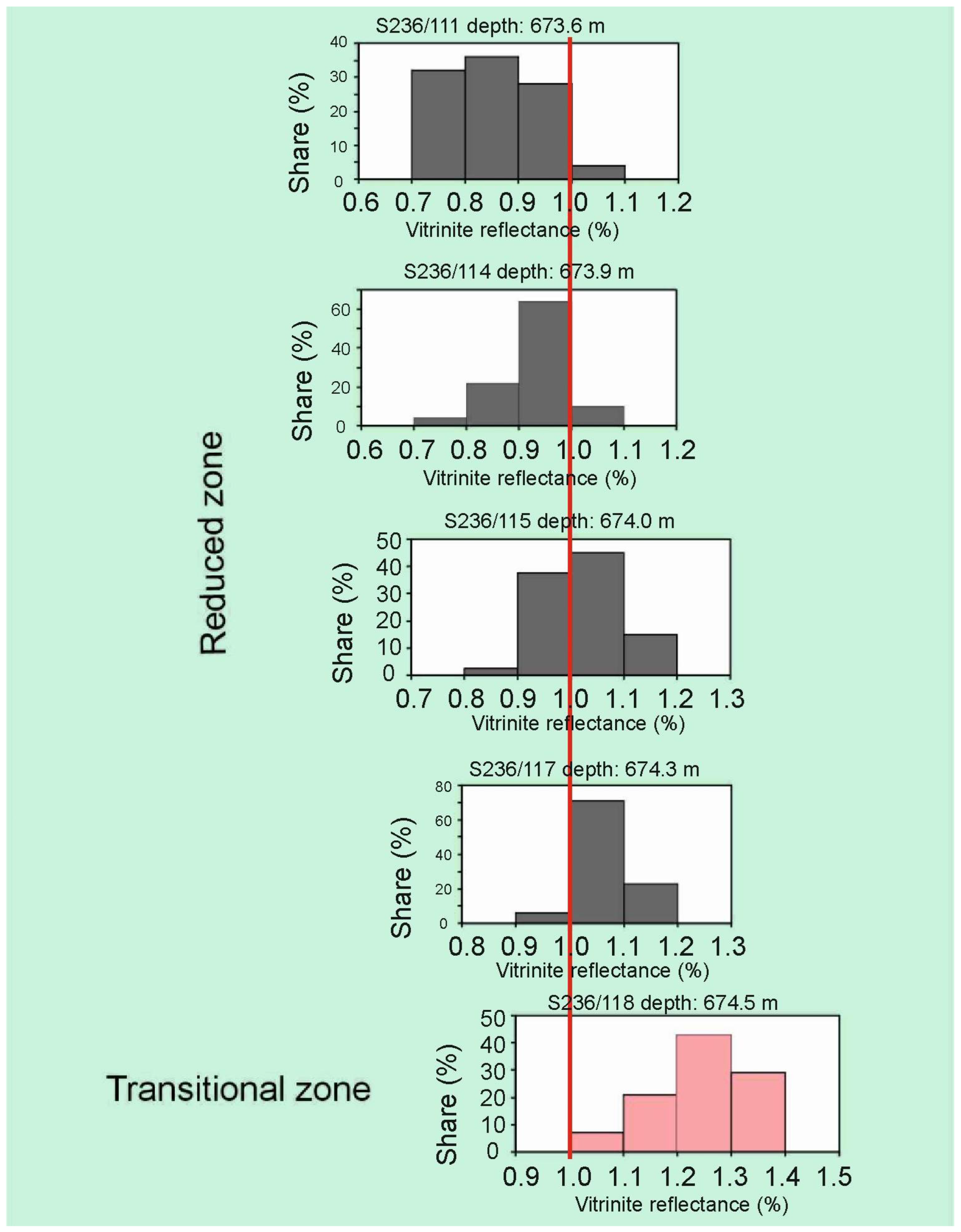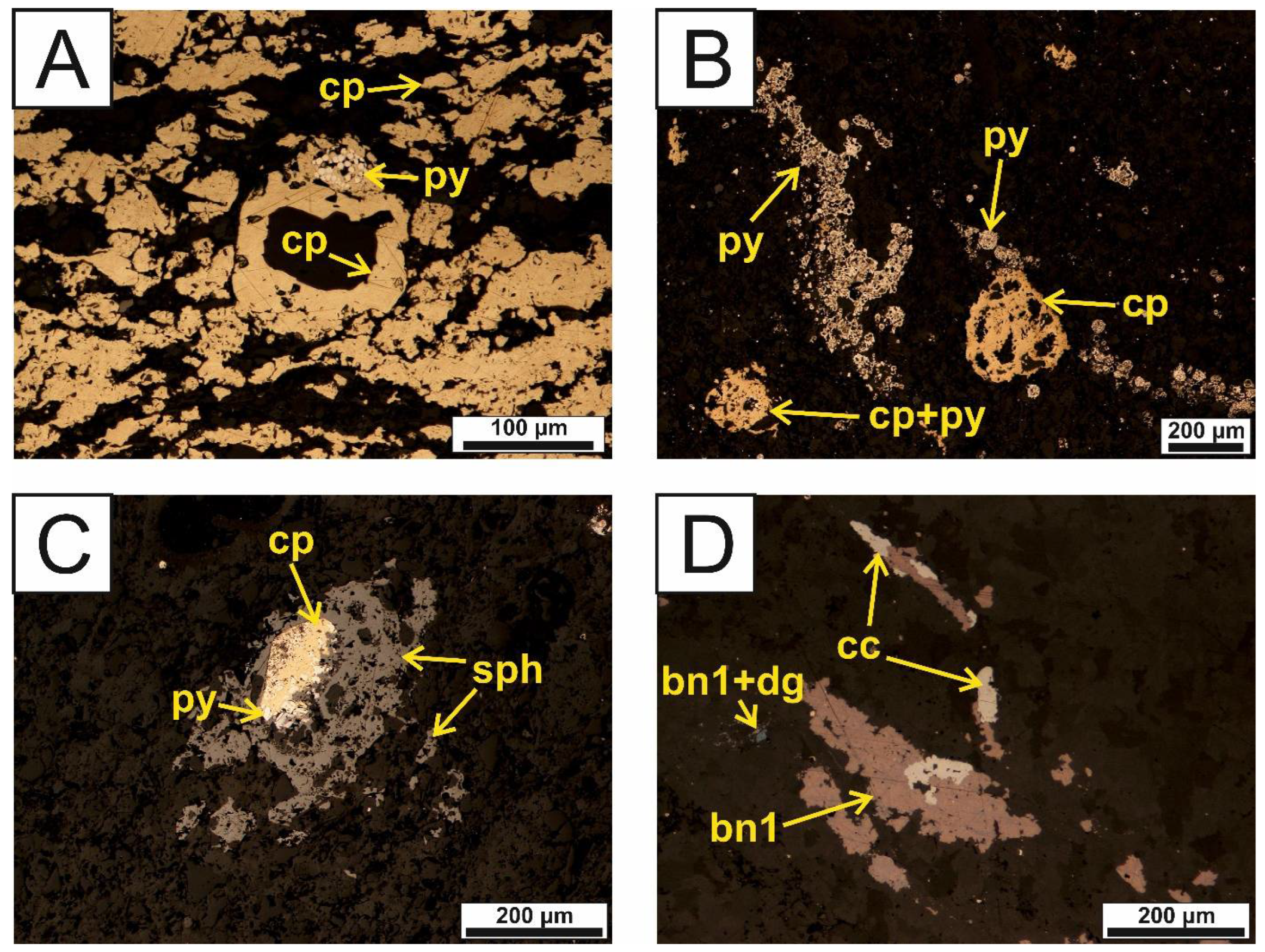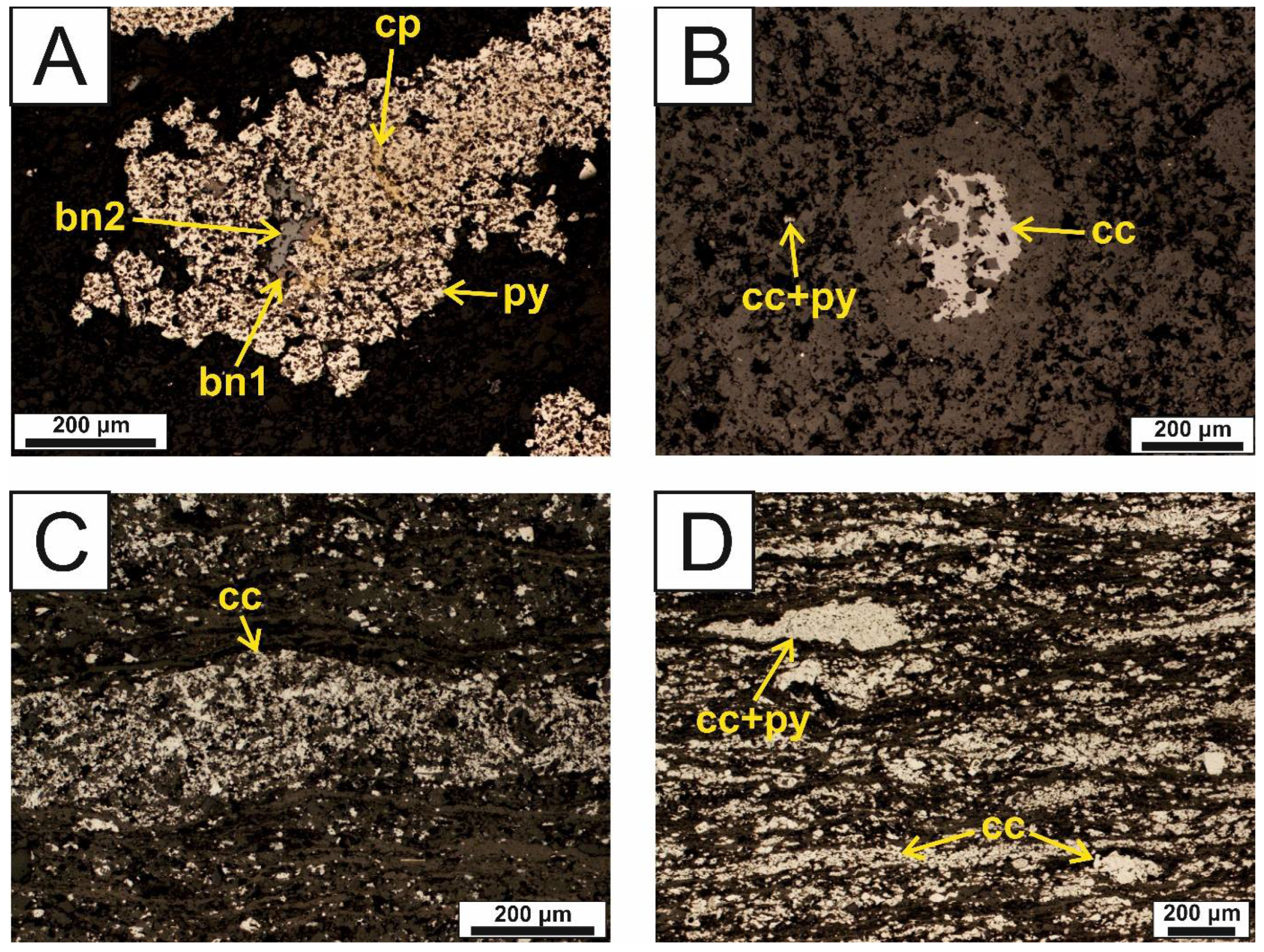Modern Geochemical and Tectonic Exploration—The Key Factor in Discovering the Northern Copper Belt, Poland
Abstract
1. Introduction
2. The Foundations of the Exploration Program
3. Tectonic Exploration
4. Mineralogical and Geochemical Copper–Silver Ore Indicators
5. Economic Significance of the Northern Copper Belt
5.1. Copper Ore Deposits
5.2. Prospective Areas
6. Characteristics of Ore in Northern Copper Belt Deposits
6.1. Distribution of Orebodies
6.2. Mineral Assemblages
6.3. Chemical Composition of Ore Minerals
6.4. Distribution of Metals
7. Tectonic Characteristics of the Northern Copper Belt Deposits
7.1. Nowa Sól
7.2. Sulmierzyce North
7.3. Mozów
8. Concluding Remarks
Author Contributions
Funding
Data Availability Statement
Conflicts of Interest
References
- Wyżykowski, J. Zechstein copper-bearing formation in Poland. Prz. Geol. 1971, 19, 117–122. [Google Scholar]
- Oszczepalski, S.; Rydzewski, A. Metallogenic Atlas of the Zechstein Copper-Bearing Series in Poland; Polish Geological Institute-National Research Institute: Warsaw, Poland, 1997. [Google Scholar]
- Oszczepalski, S.; Chmielewski, A. Predicted metallic resources in Poland: Presented on the prospective maps at scale 1:200,000–copper, silver, gold, platinum and palladium in the Kupferschiefer ore series. Prz. Geol. 2015, 63, 534–545. [Google Scholar]
- Speczik, S.; Oszczepalski, S.; Nowak, G.; Karwasiecka, M. Kupferschiefer–A hunt for new reserves. Biul. Państw. Inst. Geol. 2007, 423, 173–188. [Google Scholar]
- Oszczepalski, S.; Speczik, S. Złoża prognostyczne rud miedzi na Monoklinie Przedsudeckiej–nowa perspektywa. In Geolodzy W Służbie Polskiej Miedzi; Banaszak, A., Downorowicz, S., Leszczyński, R., Mudry, D., Eds.; Konferencja Środowiskowa Geologów: Lubin, Polska, 2011; pp. 67–85. [Google Scholar]
- Speczik, S.; Püttmann, W. Origin of Kupferschiefer mineralization as suggested by coal petrology and organic geochemical studies. Acta Geol. Pol. 1987, 37, 167–187. [Google Scholar]
- Püttmann, W.; Merz, C.; Speczik, S. The secondary oxidation of organic material and its influence on Kupferschiefer mineralization of southwest Poland. Appl. Geochem. 1989, 4, 151–161. [Google Scholar] [CrossRef]
- Speczik, S. Kupferschiefer mineralization in the light of organic geochemistry and coal petrology studies. Geol. Quart. 1994, 38, 639–650. [Google Scholar]
- Bechtel, A.; Gratzer, R.; Puttmann, W.; Oszczepalski, S. Variable alteration of organic matter in relation to metal zoning at the Rote Fäule front (Lubin-Sieroszowice mining district, SW Poland). Org. Geochem. 2001, 32, 377–395. [Google Scholar] [CrossRef]
- Oszczepalski, S.; Nowak, G.J.; Bechtel, A.; Žák, K. Evidence of oxidation of the Kupferschiefer in the Lubin-Sieroszowice deposit: Implications for Cu-Ag and Au-Pt-Pd mineralisation. Geol. Quart. 2002, 46, 1–23. [Google Scholar]
- Oszczepalski, S.; Speczik, S. Maturity assessment by Rock-Eval pyrolysis as an exploration tool, Kupferschiefer, Poland. In Smart Science for Exploration and Mining, Proceedings of the tenth Biennial SGA Meeting, 17–20 August 2009; Williams, P.J., Ed.; James Cook University: Townsville, Australia, 2009; Volume 2, pp. 734–736. [Google Scholar]
- Karwasiecka, M. Analysis of Parameters of Thermal Field in Poland, National Geological Archive, Polish Geological Institute-National Research Institute: Warsaw, Poland, 2001; unpublished.
- Speczik, S. The Kupferschiefer mineralization of Central Europe: New aspects and major areas of future research. Ore Geol. Rev. 1995, 9, 411–426. [Google Scholar] [CrossRef]
- Bieńko, T.; Wierchowiec, J.; Pietrzela, A. Silver, cobalt and nickel mineralogy and geochemistry of shale ore in the sediment-hosted stratiform Nowa Sól copper-silver deposit, SW Poland. Geochem-Explor. Environ. Anal. 2023, 23, geochem2023-035. [Google Scholar] [CrossRef]
- Oszczepalski, S.; Speczik, S. Copper and silver ores. In The Balance of Mineral Prospective Resources in Poland as of 31.12.2009; Wołkowicz, S., Smakowski, T., Speczik, S., Eds.; Polish Geological Institute: Warsaw, Poland, 2011; pp. 76–93. (In Polish) [Google Scholar]
- Oszczepalski, S.; Rydzewski, A. Copper bearing Permian rocks in areas adjoining the Lubin-Sieroszowice deposits. Prz. Geol. 1983, 26, 437–444. [Google Scholar]
- Rydzewski, A. Oxidated facies of the copper-bearing Zechstein shale in the Fore-Sudetic monocline. Prz. Geol. 1978, 26, 102–108. [Google Scholar]
- Oszczepalski, S.; Rydzewski, A. The Kupferschiefer mineralization in Poland. Zbl. Geol. Paläont. Teil I 1991, 4, 975–999. [Google Scholar]
- Speczik, S.; Skowronek, C.; Friedrich, G.; Diedel, R.; Schumacher, C.; Schmidt, F.P. The environment of generation of some base metal Zechstein occurrences in central Europe. Acta Geol. Pol. 1986, 36, 1–35. [Google Scholar]
- Piestrzyński, A. Historyczny rozwój poglądów na genezę złoża rud miedzi na monoklinie przedsudeckiej–dyskusja. Biul. Państw. Inst. Geol. 2007, 423, 69–76. [Google Scholar]
- Irvine, R.J.; Smith, M.J. Geophysical exploration for epithermal gold deposits. J. Geochem. Explor. 2007, 36, 375–412. [Google Scholar] [CrossRef]
- Basokur, A.T.; Rasmussen, T.M.; Kaya, C.; Altun, Y.; Aktas, K. Comparison of induced polarization and controlled-source audio-magnetotellurics methods for massive chalcopyrite exploration in a volcanic area. Geophysics 1997, 62, 1087–1096. [Google Scholar] [CrossRef]
- Farquharson, C.G.; Craven, J.A. Three-dimensional inversion of magnetotelluric data for mineral exploration: An example from the McArthur River uranium deposit, Saskatchewan, Canada. J. Appl. Geophys. 2009, 68, 450–458. [Google Scholar] [CrossRef]
- Znosko, J. The problem of the oceanic crust and of ophiolites in the Sudetes. Bull. Acad. Pol. Sci. Ser. Terre 1981, 29, 185–197. [Google Scholar]
- Franke, W.; Żelaźniewicz, A.; Porębski, S.J.; Wajsprych, B. The Saxothuringian zone in Germany and Poland: Differences and common features. Geol. Rundsch. 1993, 82, 583–599. [Google Scholar] [CrossRef]
- Speczik, S. Mineralizacja kruszcowa w utworach karbońskich podłoża monokliny przedsudeckiej. Geol. Sudet. 1979, 14, 77–122. (In Polish) [Google Scholar]
- Speczik, S.; Szamałek, K.; Wierchowiec, J.; Zieliński, K.; Pietrzela, A.; Bieńko, T. The new Northern Copper Belt of south-western Poland: A summary. Acta Geol. Pol. 2022, 72, 469–477. [Google Scholar]
- Dziewińska, L.; Pepel, A.; Tarkowski, R.; Żuk, Z. Nowe spojrzenie na wyniki badań geofizycznych monokliny przedsudeckiej w aspekcie poszukiwań surowców mineralnych. Biul. Państw. Inst. Geol. 2017, 468, 165–174. [Google Scholar]
- Rudnitskaya, D.I.; Danenberg, E.E.; Belozerov, V.B. Principy vydelenija sejsmociklitov v kontinentalnyh otlozhenijah jury Zapadno-Sibirskoj plity v svjazi s poiskami neantiklinalnyh zalezhej nefti i gaza. In Prikladnye Voprosy Sedimentacionnoj Ciklichnosti I Neftegazonosnosti; Nauka: Novosybirsk, Russia, 1987; pp. 67–72. [Google Scholar]
- Rentzsch, J.; Knitzschke, G. Die Erzmineralparagenesen des Kupferschiefer und ihre regionale Verbreitung. Freib. Forschungshefte C 1968, C231, 189–211. [Google Scholar]
- Rentzsch, J. The Kupferschiefer in comparison with the deposits of the Zambian Copperbelt. Annales de la Société Géologique de Belgique 1974, 395–418. [Google Scholar]
- Marowsky, G. Schwefel-, Kohlenstoff- und Sauerstoff-Isotopenuntersuchungen am Kupferschiefer als Beitrag zur genetischen Deutung. Contrib. Mineral. Petrol. 1969, 22, 290–334. [Google Scholar] [CrossRef]
- Bischof, J.L.; Radtke, A.S.; Rosenbauer, R.L. Hydrothermal alteration of greywacke by brine and seawater: Roles of alteration and chloride complexing on metal solubulisation at 200 °C and 350 °C. Econ. Geol. 1981, 76, 659–676. [Google Scholar]
- Eugster, H.P. Oil shales evaporites and ore deposits. Geochim. Cosmochim. Acta 1985, 49, 619–635. [Google Scholar] [CrossRef]
- Püttmann, W.; Hageman, H.W.; Merz, C.; Speczik, S. Influence of organic material on mineralization processes in the Permian Kupferschiefer Formation, Poland. Org. Geochem. 1988, 13, 357–363. [Google Scholar] [CrossRef]
- Radke, K.; Willsch, H.; Leythaeuser, D.; Teichmüller, M. Aromatic components of coal: Relation of distribution pattern to rank. Geochim. Cosmochim. Acta 1982, 46, 1831–1848. [Google Scholar] [CrossRef]
- Bechtel, A.; Puttmann, W. The origin of the Kupferchiefer-type minseralization in the Richelsdorf hills, Germany, as deduced from stable isotope and organic geochemical studies. Chem. Geol. 1991, 91, 1–18. [Google Scholar] [CrossRef]
- Püttmann, W.; Bechtel, A.; Speczik, S.; Fermont, W.J.J. Combined application of various geochemical methods on Kupferschiefer of the North-Sudetic Syncline, SE Poland: Evidence for post-depositional accumulation of copper and silver. In Proceedings of the 2nd Biennial SGA Meeting, Granada, Spain, 9–11 September 1993; pp. 213–216. [Google Scholar]
- Bechtel, A.; Hoernes, S. Stable isotopic variation of clay minerals: A key to understanding of Kupferschiefer-type mineralization, Germany. Geochim. Cosmochim. Acta 1993, 57, 1799–1816. [Google Scholar] [CrossRef]
- Speczik, S.; Strengel, J.; Jankowski, J. Epigenetic veins in Kupferschiefer deposits of SW Poland. Arch. Mineral. 1993, XLIX, 203–205. [Google Scholar]
- Püttmann, W.; Fermont, W.J.J.; Speczik, S. The possible role of organic matter in transport and accumulation of metals exemplified at the Permian Kupferschiefer formation. Ore Geol. Rev. 1991, 6, 563–579. [Google Scholar] [CrossRef]
- Bechtel, A.; Gratzer, R.; Püttmann, W.; Oszczepalski, S. Geochemical characteristics across the oxic/anoxic interface (Rote Fäule front) within the Kupferschiefer of the Lubin-Sieroszowice mining district (SW Poland). Chem. Geol. 2002, 185, 9–31. [Google Scholar] [CrossRef]
- Oszczepalski, S. Kupferschiefer in southwestern Poland: Sedimentary environments, metal zoning, and ore controls. In Sediment-Hosted Stratiform Copper Deposits; Boyle, R.W., Brown, A.C., Jowett, E.C., Kirkham, R.V., Eds.; Geological Association of Canada Special Paper 36; Geological Association of Canada: Ottawa, ON, Canada, 1989; pp. 571–600. [Google Scholar]
- Oszczepalski, S.; Speczik, S.; Zieliński, K.; Chmielewski, A. The Kupferschiefer deposits and prospects in SW Poland: Past, Present and Future. Minerals 2019, 9, 592. [Google Scholar] [CrossRef]
- Majorowicz, J. Problems of tectonic interpretation of geothermal field distribution in the platform area of Poland. Publ. Inst. Geophys. AB 1984, 160, 149–157. [Google Scholar]
- Speczik, S. Relation of Permian Base Metal Occurrences to the Variscan Paleogeothermal Field of the Fore-Sudetic Monocline (South-Western Poland). In Base Metal Sulphide Deposits; Friedrich, G., Herzig, P., Eds.; Springer Verlag: Berlin-Heidelberg, Germany, 1988; pp. 12–24. [Google Scholar]
- Jowett, E.C.; Rydzewski, A.; Jowett, R.J. The Kupferschiefer Cu-Ag ore deposits in Poland: A re-appraisal of the evidence of their origin and presentation of a new genetic model. Can. J. Earth Sci. 1987, 24, 2016–2037. [Google Scholar] [CrossRef]
- Downorowicz, S. Geothermics of the copper ore deposit of the Fore-Sudetic monocline. Pr. Inst. Geol. 1983, 106, 88. [Google Scholar]
- Zielińki, K.; Speczik, S. The Northern Copper Belt—A chance for a new giant copper district in Poland. In Proceedings of the 17th SGA Biennial Meeting ‘Mineral Resources in a Changing World’, Zurich, Switzerland, 28 August–1 September 2023; Volume 3, pp. 110–113. [Google Scholar]
- Pietrzela, A.; Bieńko, T. Mineralogy and geochemistry of the Kupferschiefer in the Nowa Sól, Mozów and Sulmierzyce North Cu-Ag deposits, Northern Copper Belt, SW Poland. Geol. Q. 2024; in press. [Google Scholar] [CrossRef]
- Kiersnowski, H.; Petecki, Z. Geology of the Zechstein basement of the Legnica-Głogów copper district (LGOM) and its surroundings: A critical overview. Biul. Państw. Inst. Geol. 2017, 468, 175–198. [Google Scholar] [CrossRef]
- Dziewińska, L.; Tarkowski, R.; Bieńko, T. Reinterpretation of geophysical surveys of pre-Permian basement in SW Poland: Structural evolution and its implications for prospecting Cu and other ores. Gospod. Surowcami. Min. 2020, 36, 187–216. [Google Scholar]
- Kijewski, P.; Salski, W. Zechstein rock-salt of the Z1 cyclothem in the south-western part of the Fore-Sudetic Monocline. Geol. Sudet. 1978, 13, 97–139. [Google Scholar]
- Narkiewicz, M.; Dadlez, R. Geological regional subdivision of Poland: General guidelines and proposed schemes of sub-Cenozoic and sub-Permian units. Prz. Geol. 2008, 56, 391–397. [Google Scholar]









| Company | Boreholes Logged | Boreholes Sampled for Chemical Tests (Channel Samples) | Boreholes Sampled for Chemical Tests (Discrete Samples) | Boreholes Sampled for Petrographic Tests | Boreholes Tested with the Portable XRF Analyser Only | ||||
|---|---|---|---|---|---|---|---|---|---|
| No. of Holes | No. of Holes | No. of Samples | No. of Holes | No. of Samples | No. of Holes | No. of Samples | No. of Holes | No. of Samples | |
| Ostrzeszów Copper (Warsaw, Poland) | 121 | 52 | 1176 | 9 | 73 | 67 | 471 | 1 | 18 |
| Wilcze Copper (Warsaw, Poland) | 95 | 19 | 236 | 1 | 6 | 31 | 163 | 22 | 277 |
| Zielona Góra Copper (Warsaw, Poland) | 8 | 3 | 57 | 0 | 0 | 3 | 21 | 0 | 0 |
| Mozów Copper (Warsaw, Poland) | 3 | 2 | 47 | 0 | 0 | 1 | 18 | 1 | 14 |
| Florentyna Copper (Warsaw, Poland) | 86 | 27 | 425 | 9 | 52 | 38 | 200 | 12 | 102 |
| Leszno Copper (Warsaw, Poland) | 98 | 27 | 618 | 5 | 16 | 32 | 208 | 1 | 4 |
| TOTAL | 411 | 130 | 2559 | 24 | 147 | 172 | 1081 | 37 | 415 |
| Nowa Sól | Sulmierzyce North | Mozów | Total NCB | |
|---|---|---|---|---|
| Polish category | C2 | C2 + D | C2 | C2, C2 + D |
| Ore (Mt) | 846,262 | 267,171 | 223,589 | 1,337,022 |
| Copper (kt) | 10,959 | 5431 | 4269 | 20,659 |
| Silver (kt) | 35.32 | 6.89 | 5.72 | 47.93 |
| Lead (kt) | 1640.73 | 715.99 | 28.50 | 2385.22 |
| Zinc (kt) | 402.38 | 1132.40 | 14.65 | 1549.43 |
| Cobalt (kt) | 15.92 | 22.64 | 2.66 | 41.22 |
| Molybdenum (kt) | 18.56 | 25.99 | 6.55 | 51.10 |
| Nickel (kt) | 15.00 | 18.89 | 9.26 | 43.15 |
| Vanadium (kt) | 22.21 | 44.54 | 31.31 | 98.06 |
Disclaimer/Publisher’s Note: The statements, opinions and data contained in all publications are solely those of the individual author(s) and contributor(s) and not of MDPI and/or the editor(s). MDPI and/or the editor(s) disclaim responsibility for any injury to people or property resulting from any ideas, methods, instructions or products referred to in the content. |
© 2024 by the authors. Licensee MDPI, Basel, Switzerland. This article is an open access article distributed under the terms and conditions of the Creative Commons Attribution (CC BY) license (https://creativecommons.org/licenses/by/4.0/).
Share and Cite
Speczik, S.; Zieliński, K.; Pietrzela, A.; Bieńko, T. Modern Geochemical and Tectonic Exploration—The Key Factor in Discovering the Northern Copper Belt, Poland. Processes 2024, 12, 1592. https://doi.org/10.3390/pr12081592
Speczik S, Zieliński K, Pietrzela A, Bieńko T. Modern Geochemical and Tectonic Exploration—The Key Factor in Discovering the Northern Copper Belt, Poland. Processes. 2024; 12(8):1592. https://doi.org/10.3390/pr12081592
Chicago/Turabian StyleSpeczik, Stanisław, Krzysztof Zieliński, Alicja Pietrzela, and Tomasz Bieńko. 2024. "Modern Geochemical and Tectonic Exploration—The Key Factor in Discovering the Northern Copper Belt, Poland" Processes 12, no. 8: 1592. https://doi.org/10.3390/pr12081592
APA StyleSpeczik, S., Zieliński, K., Pietrzela, A., & Bieńko, T. (2024). Modern Geochemical and Tectonic Exploration—The Key Factor in Discovering the Northern Copper Belt, Poland. Processes, 12(8), 1592. https://doi.org/10.3390/pr12081592







